Valentia Southern Ireland
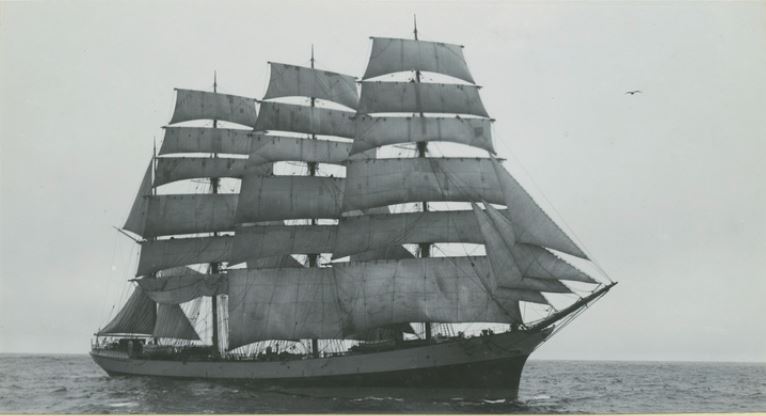
Thomas Royden, a master carpenter, opened a shipyard on Baffin Street on the west side of Queens Dock, Liverpool in 1818. Thomas Royden was an English ship-owner and Conservative Party politician. After a brief partnership with James Ward as Royden & Ward in 1819-20, he eventually took his two sons, Thomas Bland Royden and Joseph Royden, into partnership and the company was renamed Thomas Royden & Sons in 1859 (Royden. M “The Roydens of Frankby a Brief History of a famous Wirral family” Royden Family History Pages – The Roydens of Frankby (roydenhistory.co.uk) On Line resource: Accessed 26/10/21): “In 1808 Thomas moved to Liverpool and secured employment as a master carpenter with Charles Grayson, a prominent shipbuilding firm. There was a brief lull in trade and shipbuilding during the period of his employment, mainly due to trade restrictions resulting from the wars with France and America, but by 1818 Thomas was confident enough to set up his own yard to capitalise on the consequent resurgence. The site was Baffin Street on the west side of Queens Dock, and Thomas lived nearby in Harrington Street. The business grew steadily and despite a devastating fire in 1825, success continued while several other shipyards folded around him. 1825 also saw his marriage to Ann Dean, step-daughter of Thomas Bland of Bland, Chaloner Co, another established Liverpool shipbuilder” Thomas Royden & Sons expanded by acquiring a neighboring Queens Dock shipyard from Peter Chaloner & Son in 1863, shipbuilding was changing rapidly at the time and Royden & Sons made the transition from building wooden to iron-hulled ships, Thomas Royden, perhaps unwilling to embrace the transition from wooden to steel ships himself, retired, leaving the company in the hands of his son Thomas Bland Royden. The increased size of the combined yards facilitated a gradual increase in output, from six ships in 1866 to twelve in 1869, in 1890 The Royden Yard Built The SV Crompton for their client MacVicar Marshall & Company
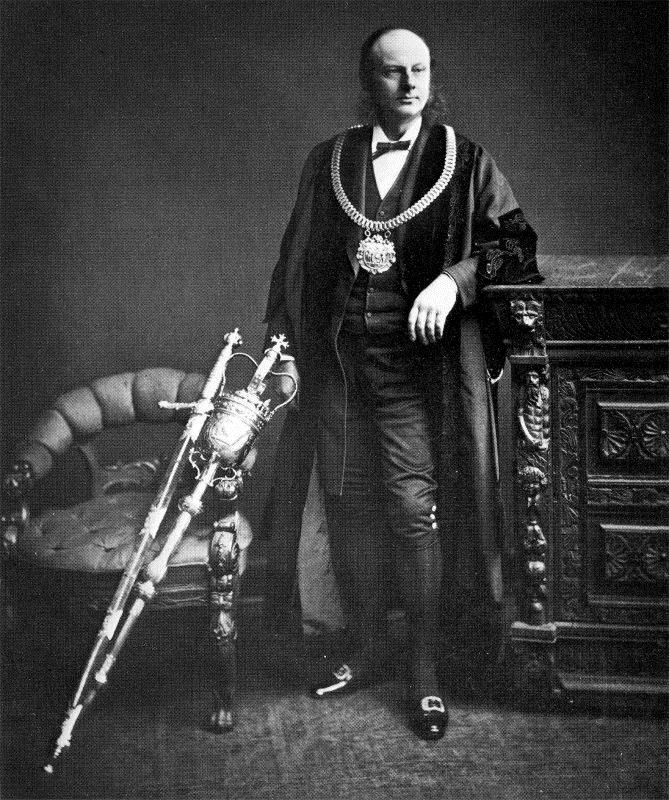
Thomas Bland Royden became a member of Liverpool City Council in 1873, and was elected Mayor of Liverpool in 1878–1879. Thomas & his family, two sons (Thomas & Ernest) and six daughters, lived at Frankby Hall on the Wirral. Thomas became a Justice of the Peace for Liverpool and was elected Member of Parliament for Liverpool West, Toxteth, eventually standing down in 1892. Thomas was appointed High Sheriff of Cheshire in 1903, and then a deputy lieutenant of Cheshire at the end of that year,two years later being made Baronet Royden on 29 July 1905. He died 29th August 1917 at the age of 86
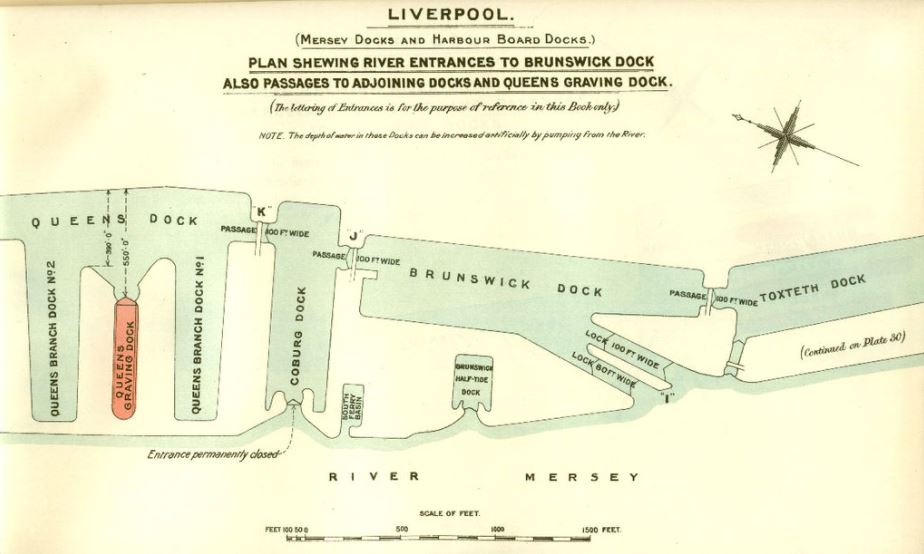
The company also began operating its own ships, founding the Indra Line in 1888. This came to dominate the company’s activities, and in 1893 Royden’s sold their shipyard to concentrate on shipping operations and management. In another of those 5 degrees of separation, given my Father’s maritime history, Royden’s sold the Indra Line to Alfred Holt’s Blue Funnel Line in 1915, and from 1916 operated the Santa Clara Steam Ship Company on the South American route. The Santa Clara Company was eventually sold to the Bristol City Line in 1930 finally bringing Royden’s independent shipping operations to a close

From the volume ‘British Owned Iron and Steel Ships (IV) Masted Barques and Ships’.
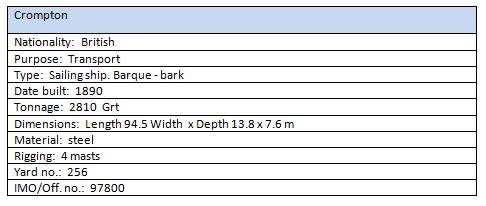
The Crompton’s Owners were MacVicar, Marshall and Co. registered in Liverpool: (Graces Guide to British Industrial History: “1914 Who’s Who in Business: Company M” On Line resource https://www.gracesguide.co.uk/ 1914_Who%27s_Who_in_Business:_Company_M Accessed: 26/10/2021) “Macvicar Marshall & Co: Shipowners, 13, Castle Street, Liverpool. Hours of Business: 9.30 a.m. to 5 p.m. Established in 1882 by A. R. Marshall and Neil Macvicar (d). Present Principals: A. R. Marshall, P. Hugh Marshall and William Pritchard. Claim to have been owners at one time of some of the largest sailing-ships in England. Premises: Consist of the front second floor at Queen Insurance Buildings, Castle Street, Liverpool. Staff: Seven, and Consulting Engineer and Marine Superintendent. Business: Steamship Owners and Insurance Agents. Connection: United Kingdom, Foreign and Colonial. Telephone: No. 844 Central, Liverpool. Telegraphic Address: “Martial, Liverpool.” Codes: Scott’s, ABC and Watkin’s. Bankers: London City and Midland Bank Ltd., and Parr’s Bank, Ltd. Clubs: Exchange and Conservative, &c.,” Liverpool, MacVicar Marshall & Co survived as shipowners up until a couple of months prior to the grounding of the Crompton in 1907
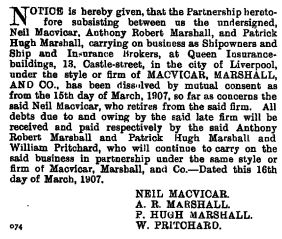

On 23rd November 1910 the Crompton was en route from Tacoma to Limerick filled to the gunwales with grain, when she encountered a combination of bad weather and fog and ran aground on rocks at Dromgour Point near Port Magee, Ireland. Crompton was carrying 38,233 sacks of Wheat, weighing 2700 tons, from the Tacoma, Washington state in the USA. Why bring wheat in from the USA when the UK & Ireland produce wheat themselves, well this was the 1900’s and industrialization was concentrating the majority of the population into cities, specifically, the major employers were new industrial factories, people were no longer content eking out a hand to mouth existence on small-holdings, even larger scale farmers were under pressure and struggling to produce sufficient crop to meet the needs of the growing population, import was becoming more and more inevitable as the UK became less and less able to meet the requirements for food from her own lands and farming techniques, but the vast spaces of the USA were ideal for huge crops, more than sufficient for the needs of their population…..with plenty to spare for export and the revenue that would bring……huge ships like the Crompton were queuing up in Tacoma to fill their holds for the journey East across the Atlantic
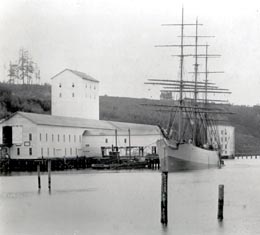
The background to the Crompton’s transatlantic journeys, her embarkation from Tacoma, Washington State in Southern USA, her stop in Melbourne, Australia and her passages across the wild Atlantic ocean were a part of the wheat trade between the Great Britain and the USA, at that time just a hundred or so years on from having been a colony of the British Empire, but now well-established as an independent trading nation and just as happy to sell her produce, wherever there were buyers, as Great Britain was to feed her growing industrial cities………
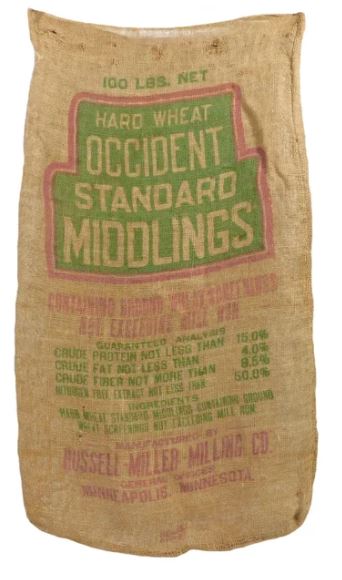
There is an interesting potted history of the US Southern States Wheat trade by Norman Reed, which details the Tacoma area wheat farming and export, I think it adds some context to both the development of the USA as a global trading nation and also to the background of the Crompton and its eventual loss off Valentia (Reed, N. “Flour Milling in Washington — A Brief History” On Line resource: https://www.historylink.org/File/9474 Accessed 27/10/2021): “……..Every farm community needed a mill within horse-and-wagon distance so that the annual crop could be milled into flour. As mentioned, it all started at Colville and eight mills were running in Stevens County in the years between 1816 and 1889. As the settlers arrived over the Oregon Trail and became acquainted with the soil they discovered that Eastern Washington was extraordinarily suited to growing wheat. Wheat grew everywhere — on the round tops of hills, on the benches, on the plateaus and foothills. No irrigation was necessary, and the rich soil required no fertilizing. The earliest railroads were established for the grain and flour trade. Eastern Washington’s wheat was already being exported out of Portland and to areas as far away as Liverpool, England. Between 1880 and 1893 the Pacific Northwest experienced a rate of growth seldom equaled in any section of the United States. Tacoma’s and Spokane’s growth were even more impressive. This growth was, in great part, the result of the development of the railroads and their aggressive advertising. The flour-milling industry reached its heyday at this time. Spokane was said to rank as the seventh largest milling center in the nation by 1900, ranking just behind such locations as Niagara Falls, Grand Rapids, and Minneapolis-St. Paul.”
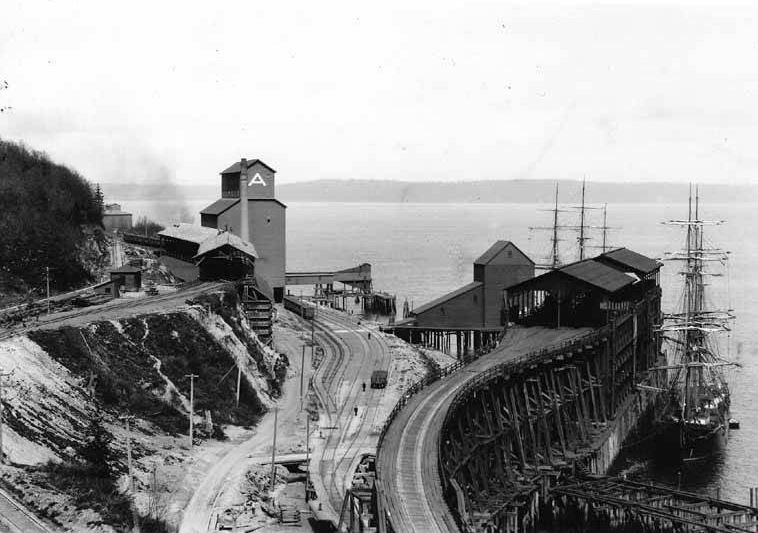
Reed goes on to mention the rapid expansion of the wheat and flour trade in the Tacoma area and Portland: “The trade with the Orient and the growing Western Washington population encouraged larger and more modern flour mills to be established in the Puget Sound cities. First in Seattle was the Novelty Mills, out towards West Seattle. Centennial built its mill on the waterfront just south of the current sports domes, opening in 1898. By 1906 that stretch of waterfront was home to three mills: the Hammond Milling Company, Albers Cereal Mills, and Centennial. The Fisher Flouring Mills opened on Harbor Island in 1911. Seattle now had seven mills, as the Chas. Lilly Company produced flour as well as seeds, feeds, and fertilizer, and City Mills was just north of downtown. Tacoma had the Puget Sound Flouring Mills, the Tacoma Grain Company, Watson & Olds, Albers Milling Company, and the Cascade Cereal Mills. Everett had the Everett Flour Mill producing its “Best Everett” brand. Bellingham had a big mill on South Hill next to the water, where the three-masted schooners could easily load up. The grain trade was huge as well. Tacoma had a mile-long grain warehouse on the waterfront, handling wheat. Railroad trains stopped on the shore side and the great ocean-going schooners tied up at the water side for loading. Large quantities of Washington’s wheat also shipped out of Portland and Astoria. Combined, the grain and flour trade was our state’s major industry”
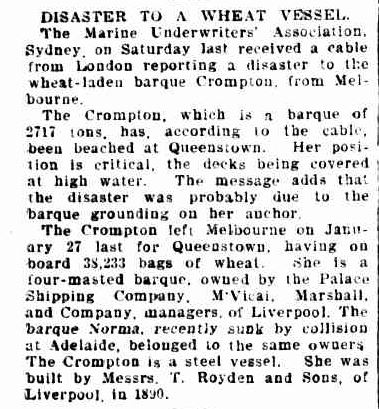
It is anomalous to say the least to find the Crompton described in the (Sydney, Australia) Examiner newspaper, wrecked in 1907 rather than her generally accepted & recorded loss of 23/11/1910 (“S V Compton (+1910)” www.wrecksite.eu/wreck.aspex?148392 On Line resource: Accessed 26/10/2021). Working back from the date of the Examiner report “…on Saturday last received a cable, been beached at Queenstown.…” given that the report is in the paper of Saturday 11th May 1907, it then would indicate the report from London arriving in Sydney 04th May of 1907 leaving the Crompton lost at best sometime in the month leading up to May 04th of 1907 (“DISASTER TO A WHEAT VESSEL” (Editorial) in The Examiner, May 11 1907. Shipping, P6, Para 5. On Line resource: https://trove.nla.gov.au/newspaper/article/45812966 Accessed 26/10/2021) If nothing else, we are putting historical records streight by revealing the correct time of the loss of the Compton, even if the exact day has been lost. If the Compton left Melbourne, as described in the Examiner, January 27th of 1907 we can search other sources to see if we can better identify the exact day and month of her loss. The New Zealand Mail of 1907 confirms the press association telegraph from London in its article “Marine Mishaps” of May 06th (Editorial: “Marine Mishaps, Wheat ship ashore”. New Zealand Mail: Issue 1835, 08th May 1907, P35. In “paperspast.natlib.govt.nz/newspapers/NZMAIL19070508.2.101” On Line resource. Accessed 26/10/2021) describing “…..the barque Crompton, bound from Melbourne to Queenstown, with 2700 tons of wheat, has been beached at Queenstown.”
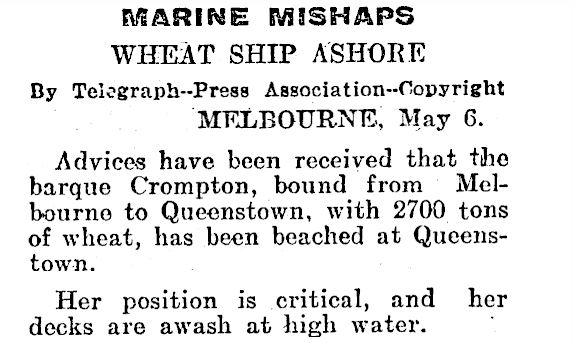
A little further digging in local archives, with the assistance of Michael Lynch of the Kerry County Library, unearthed a copy of the Irish Examiner dates 03rd May of 1907 which carries far more detailed descriptions of the Crompton’s fate at Queenstown (Editorial “Ship aground at Queenstown” Irish Examiner 03.05.1907 P5 C2 ) “The four –masted ship Crompton, of Liverpool which arrived yesterday with 20,310 quarters of wheat from Melbourne, for orders went aground on her anchor to-day, and had to be beached on the Spike Bank, where she now lies with tugs still holding her.”
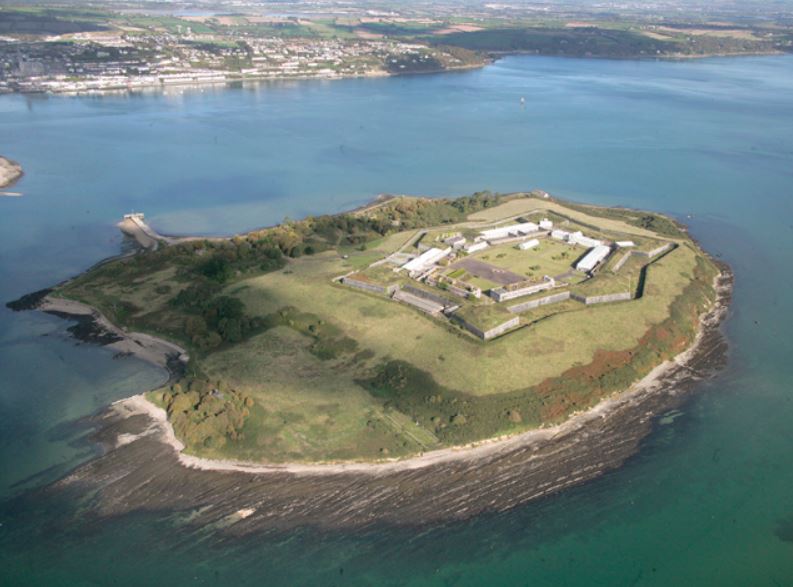
The Irish Examiner piece goes on to describe a series of unfortunate events that our friend Lemony Snicket would have found fascinating….. The Crompton arrives at Queenstown, modern day Cork, on the 02nd of May of 1907, she is assigned a pilot, a Mr Samuel Dean (difficult to ascertain as the print of the Examiner clip is less than perfect) and sails perfectly well to her mooring point noted as being west of No 7 Buoy at “Chapel Hole”. The Crompton is said to be “….drawing 23 feet of water on arrival and the depth of water at the point where she was moored is in or about from 23 to 26 ft. at places…” Now a ship of the size of the Crompton and drawing 23 feet of water (the amount of her hull in and under the water) is not going to last long in water the same depth or slightly deeper in places, she is a disaster waiting to happen at that point and it seems everyone knew about it as the Irish Examiner notes “….It seems quite clear that those in authority did not approve of the berth she was in. for the pilot remained on board all night with a view to getting her into another berth to-day, and accordingly about noon today she had her port anchor up.” So all preparations are in place and it seems the Crompton is about to be moved to a more appropriate depth of water and moored correctly, but the day was not going to be saved, the weather was in no way ideal to move such a big ship and a gale was blowing down the harbour from the West to North West. Now a gale blowing West alone might have saved the Crompton, that would have blown her towards the deeper channel into Cork, but all North West winds would have blown her closer to the Spike Island fort and shallower water and the Irish Examiner reports exactly that “….During today’s gale from W.N.W setting on her port side she got on the ground, and appears to have got her own anchor under her, with the result that she became badly holed Both anchors were down when she grounded, that which was previously lifted with a view to shifting her having been again let go.” It became a matter only of time, the Crompton being badly holed by her own anchor (perhaps even the anchor mounted in Queenstown, Valentia, outside Des Lavelle’s Dive Center?), and a gale pounding her sides, tons of water would be pouring in through such a hole, the Examiner piece notes that at 16:30 she had 2 feet of water in her and 18:30 she had 16 feet in her hull, later the author states “….as I write, at 8 p.m. the water appears to be within one foot of her main deck. In other words the ship is full of water and in a most precarious condition.”
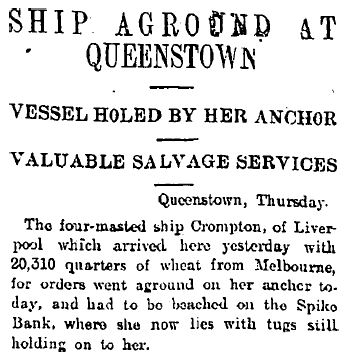
At some time during the events unfolding signals were run up calling for assistance and the local tug company, which was, oddly the Clyde Company of Scotland, (owning the local steam tug boats for harbour duties, and using a local manager to do so) who’s manager a Mr J J Brennan set to, sending 3 tugs to assist the Crompton, the Flying Fish, the Flying Fox and the Flying Sportsman. It was decided by the Captain of the Crompton, who had come back aboard after seeing the distress signal flags from ashore (where he was dealing with the local shipping agent, a Mr J Kelleher of Scott and company, in relation perhaps, to the Crompton’s cargo or onward journey), and agreed with the Tugs agent to drive the Crompton onto the bar at Spike island which would see her grounded but safe from further sinking. The Examiner details the activities undertaken “…..it does not take long to put a ship aground, difficult though it is to take her off again, and the Flying Fox at her helm and the Sportsman and Fish at her port and starboard side respectively, took hold of her and all three vessels, finely handled, safely beached the ship and kept attendance on her during the night until further danger was averted, as it was possible she might have dropped off if let go.”
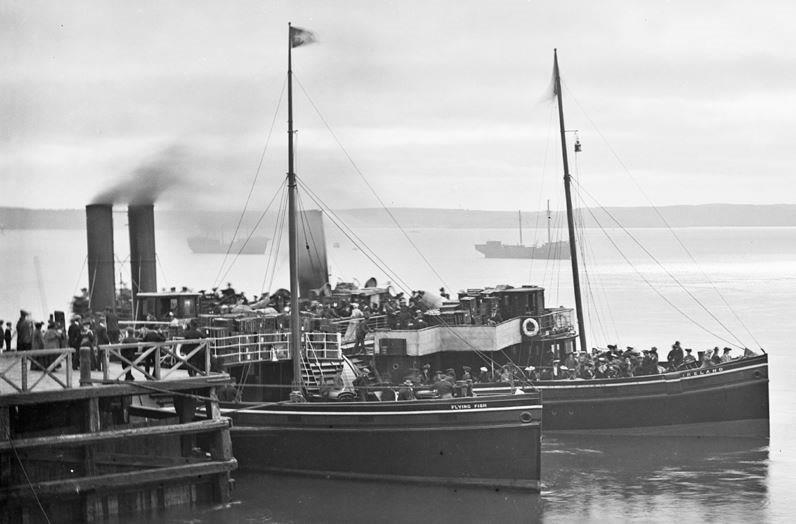
The three tugs of the Clyde Company must have had a very difficult task during the dying hours of the night of the 02nd May 1907, the Crompton was full to a foot of the main deck with water making her a huge almost dead weight, and the weather was horrible with a W.N.W gale blowing against them to make things even harder….it is no surprise the tugs come in for praise for their actions, little short of miraculous in the circumstances and recognised by the Examiner “…..Mr Henry T. Ensor and his salvage staff reached the ship very promptly after the appearance of the signals and rendered valuable assistance, and as I write Messrs. Ensor and staff with their powerful pumps are on board pumping the ship, aided by the crew but it is difficult to keep down the inrush of water to the ship” and goes on to note “The tugs Blazer, Columbia and the Government tug Stormcock proceeded to the ship’s assistance, but the Clyde Company’s tugs did all the work required of them” in effect praising Flying Fish, Fox and Sportsman for the saving of Crompton whilst noting others were there after the main of the dangerous and professionally challenging work had been completed. It would not be the last time the Flying Fish showed her mettle, a mere 7 years after the Crompton grounding she would take part in a far more tragic sinking, the Lusitania, off Kinsale Head on 07th of May 1951 under her Captain Thomas Brierley, the Cobh and Cork Harbour Centenaries Facebook site has a quotation which sadly is not referenced but details “……the Flying Fish made several such trips, gathering and ferrying survivors from the scene to Queenstown, and many of those survivors owed their lives to him and his vessel……….. Captain Thomas Brierley was born in 1859, and was 56 at the time of the disaster. He was awarded a medal for the outstanding gallantry he displayed during the endless trips he and his vessel made back and forth from Queenstown, to where the Lusitania had sunk. Bringing back the living, as well as the dead”

The Examiner notes the crew were taken off the Crompton at around midnight and taken to the “sailors Home” (presumably the local lost sailor’s mission), but that her captain and the ship’s officers stayed aboard. The Examiner also notes the exact location of the damage is still to be determined and that divers will probably have to remove most of the cargo to find and repair the damage from Crompton’s anchor, but that the salvage values could, if Mr Henry Thomas Ensor and his divers manage it, value £20,000 for the Crompton herself and £30,000 for the wheat with freight at around £7,000. If anyone could achieve this, in the circumstances, it would be Henry Thomas Ensor, who would be described in the Wonders of World Engineering (Editorial in: https://wondersofworldengineering.com/salvage_engineers.html On Line resource: Accessed 30/10/2021) following his salvage of the huge dredger Silurus, 81m Long, 14m wide and 6m deep weighing over 2,000 tons, sunk in a gale in October of 1915 after breaking her moorings in Gareloch, Scotland, as: “……..the late Henry Ensor, of Queenstown (Cobh), Ireland, who was one of the most brilliant exponents of marine salvage. A red-bearded man of average height and slight build, he had a quiet voice and bore little resemblance to the popular conception of a man who had spent his days grappling with intricate salvage problems”
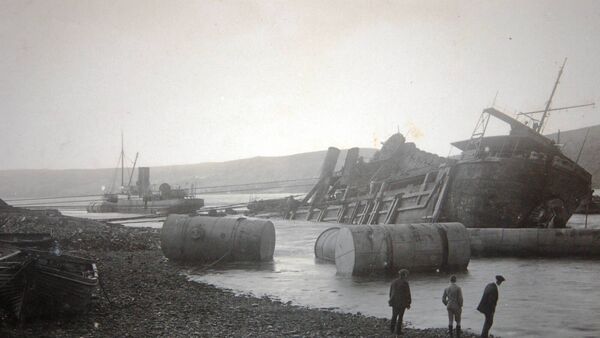
It seems Crompton was both a lucky vessel of sorts, and doomed, as are we all, to a fatal end, a little more digging with the Kerry County Archivist, Michael Lynch, at the Kerry Library reveals the 1907 grounding to be only the first of the Crompton’s adventures with the Kerry coast. Indeed the 1907 grounding reported in Australia and New Zealand and in the Irish Examiner was followed a mere three years later with the Crompton’s sinking in her current resting place off Dromgour point, Valentia Island County Kerry. Michael has kindly supplied pieces from the local newspapers, the Cork Examiner, the Kerry Evening Post and the Kerry Weekly Reporter and carrying reports of the ultimate demise of the Crompton where previously the only mention found was Antipodean, nothing evident or easily accessible from the various internet sources. If nothing else it shows the value of Library copies of local newspapers and the archival benefits of local and county libraries, the internet is an amazing resource, but it will be decades before it has the full human archive available at your fingertips in any “complete” sense, and if I do not miss in guessing, that will come at a cost as more and more web based archives charge for access privileges……. It is only 3 years later and the Crompton is again aground on the coast of Kerry, this time against Drumgour and with little, if any, chance of survival as the report in the Kerry Evening Post of 26th November 1910 details
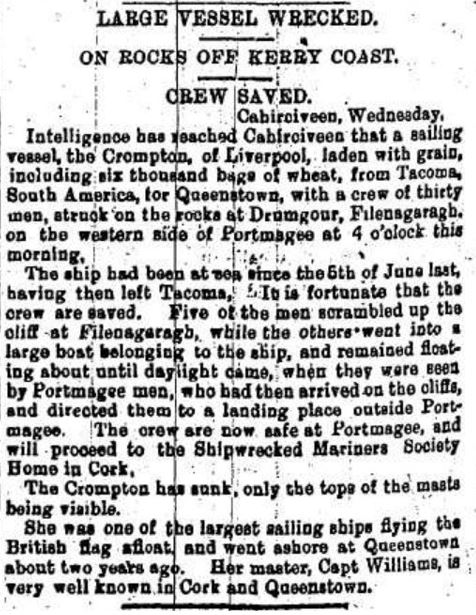
There was no chance on this occasion that salvage could be made as the report clearly states “The Crompton has sunk, only the top of the masts being visible” for a barque of 17 years and veteran of many Atlantic crossings to be lost in this manner would mean the economics of salvage would not add up, effectively she and her cargo are lost and all that remains is the destructive effects of the sea and the Crompton’s position below the unforgiving cliffs at Drumgour on Valentia
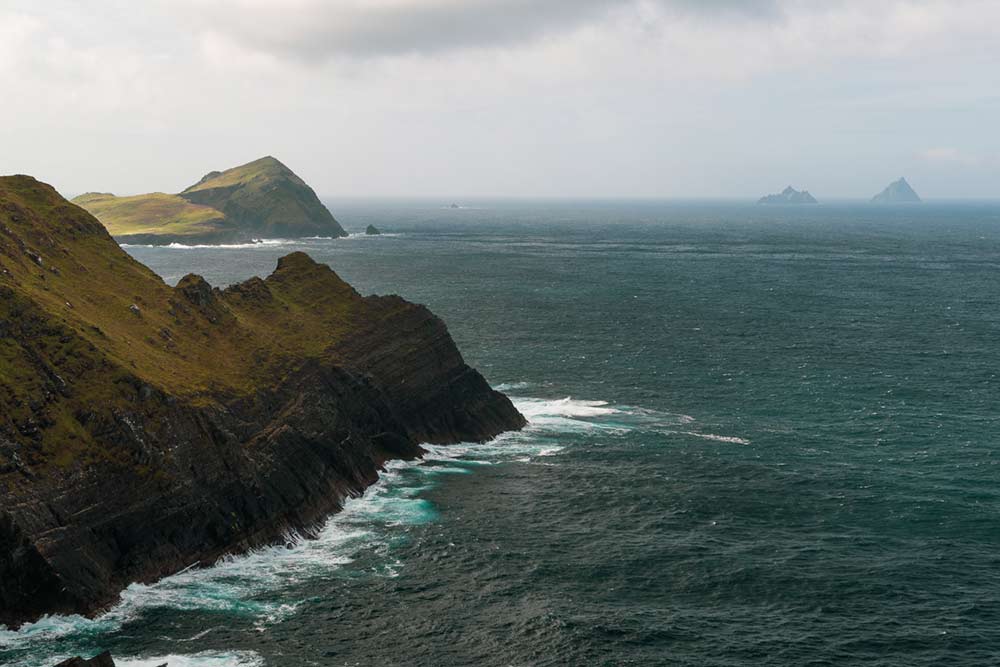
I dived the Crompton, or what remains of her, from Des Lavelle’s boat, Bael Bocht, (from the book An Béal Bocht (meaning “the poor mouth”) by Flann O’Brien (pen name of Brian O’Nolan) a classic satire in Irish, parodying the expression attributed to Irish farmers to “put on the poor mouth” or exaggerate their poor circumstances to invoke sympathy……… You see Des, I did eventually find out!) on a trip to Valentia & the Skelligs in 1998, this was the first trip I had taken to Ireland specifically to dive, (my last trip involved a great deal of walking, usually dropped off by Lynx or Puma, sometimes collected by them too, when not too close to the north-South border)…… I was struck by the warmth of the Irish, their welcoming nature and quick wit in any situation, the country is beautiful and Valentia and Kerry were like stepping back in time 40 years, charming people, beautiful countryside and a warm welcome, idyllic, truly idyllic…….
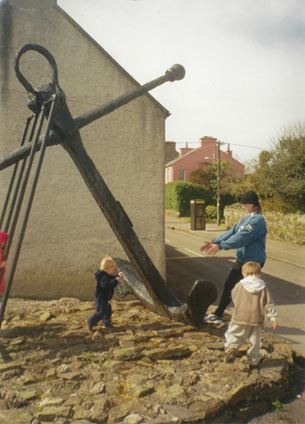
Des Lavelle is a very well known and well respected senior of the Queenstown community having been one of those working for the Atlantic Telegraph Company based on Valentia, the first landfall of the Transatlantic sub-sea telegraph line between the USA & Ireland. It was Des’ boat the Bael Bocht that was the dive platform for the retrieval of the Crompton’s main anchor, now sat outside Des’s dive centre in Queenstown Valentia. On his retirement from the telegraph company Des used his little boat to take out tourists to Skellig Michael & Small Skellig, visible on the Drumgour Cliffs photo, to visit the ancient monks slate beehive huts, and spend time with the remote islands wildlife and sea life. The local seals, Gannets & Puffins are well loved and popular with divers and tourists alike, those of you of a certain age and possessed of perhaps even a small degree of “the force” will perhaps recognise the Skelligs, at least Skellig Michael
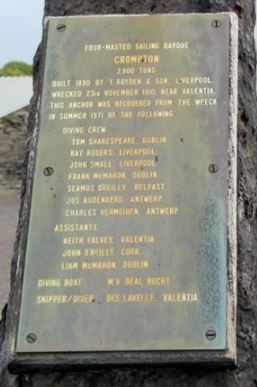
My little Red Log book records the dive: “13 04 98 Valentia Eire WRECK OF “CROMPTON” A four masted Barque that was wrecked in 1910 & not discovered again till 1970. The main anchor is on Des Lavelle’s forecourt. We dropped onto the second anchor – slightly smaller & quickly found the mass of rusting chains from the for’ard chain locker & then ferreted back amongst the spars & plating back to a great little rock “squeeze” & back up to find the 3rd anchor & more chain – great ferret about & well worth another visit great viz” The wreck was well broken up even then, hardly surprising as it is at the base of cliffs with nothing between the cliffs and the raging Atlantic from the USA across to Ireland! The sheer force of the sea can only truly be appreciated in a storm, I watched the Grey mountainous seas smash against the cliffs on a later trip to Valentia when we lost 2 days to harsh seas and storm and did some walking in the area, the conditions below us were extreme and those fleeing the sinking Crompton were incredibly lucky to escape with their lives, it’s little short of a miracle all the Crompton’s crew were saved

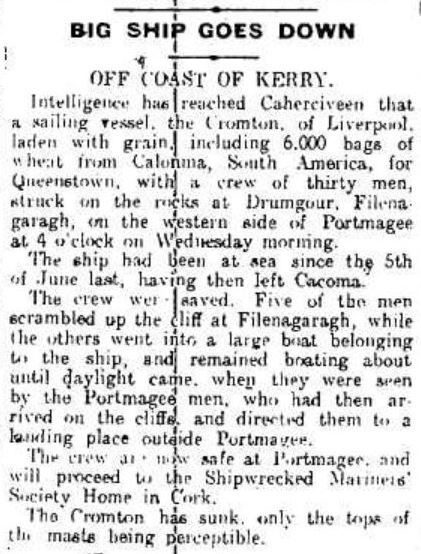
The Kerry Evening Star reports “Five of the men scrambled up the cliff at Filenagaragh…” which is a considerable feat in the circumstances and would also have come as a shock to the locals on Valentia, confronted by 5 bedraggled and likely scraped and bleeding negro sailors from the Southern states of the USA, a not so usual sight on a Southern Irish Island such as Valentia. The memorial in Valentia adds a little detail to those climbing the cliff and their circumstances “…..the crew scrambled up the rocks and made off the houses of Jeremiah O’Sullivan and Sean More Devane where they were fed and cleaned up. The next day they were met by Harbour Master Shanahan and brought to Caherciveen where they were put on a train to begin their long journey home.” Who knows, there may have been some present who assisted in the 1907 grounding, there may be more to write about in family archives locally or sleeping in long defunct local newspapers, there is nothing written I can find other than the pieces shared here, and I suppose it fitting in rounding up this piece, to mention the rather cryptic line in the Kerry Evening Post: “….Her Master, Captain Williams, is very well known in Cork and Queenstown…..” Now I’m not exactly sure how to take that, being predisposed to a naturally suspicious nature myself, hopefully it is just a bit of the Irish Craic in reference to the 1907 grounding of the Crompton
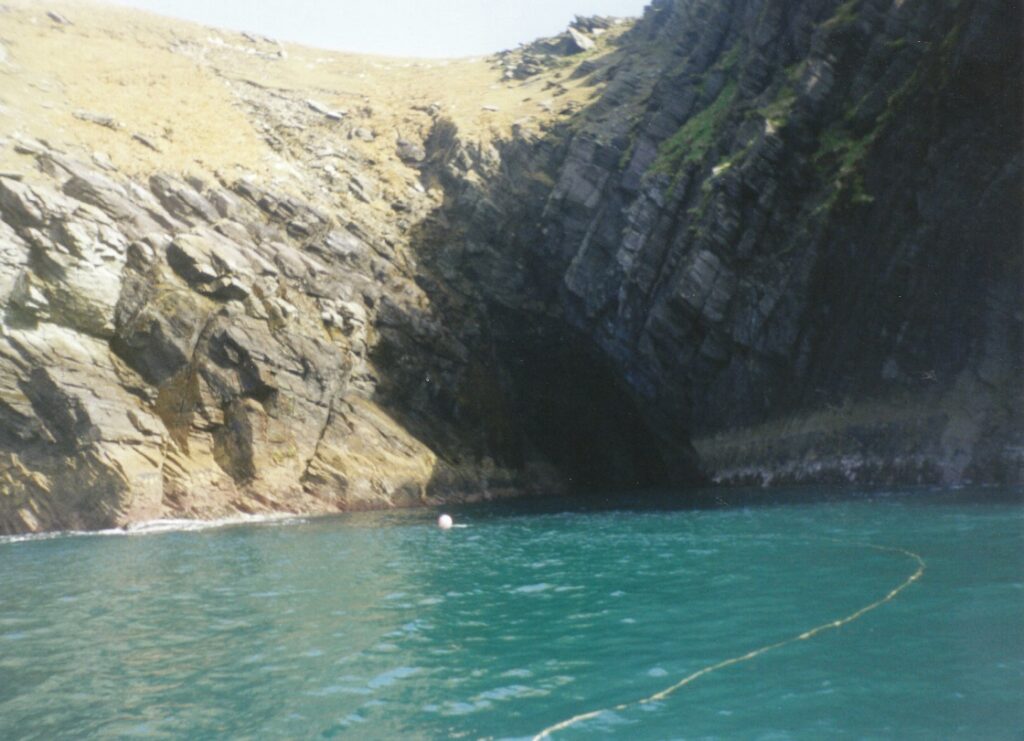
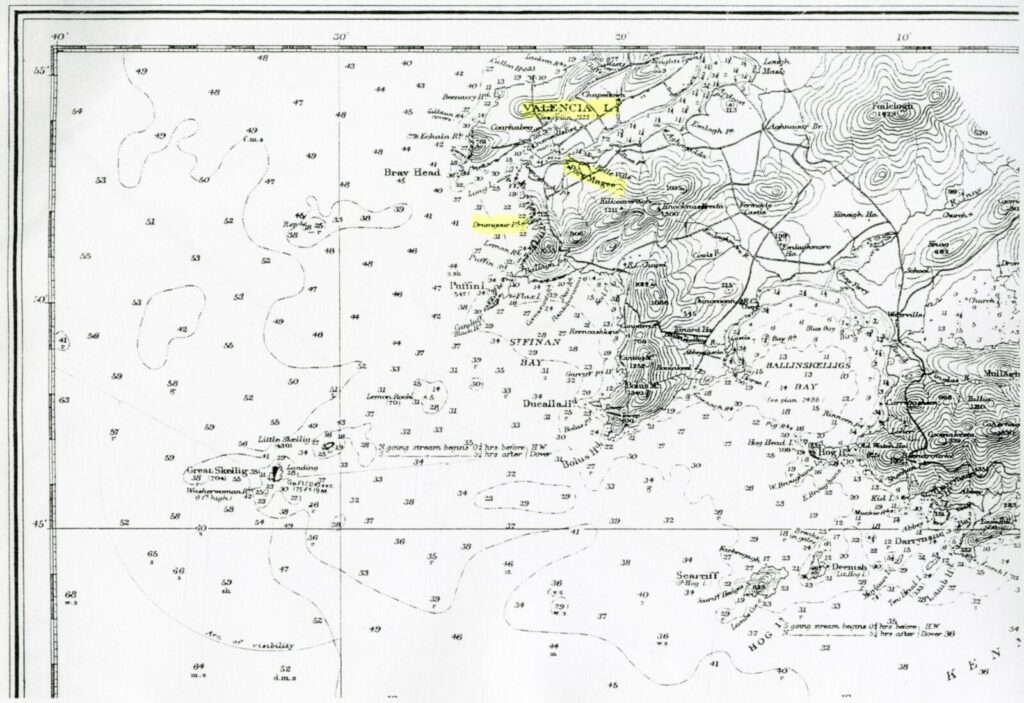
I recall the dive very well, not so much for the wreckage of the Crompton, this is another very similar to the Barque Herzogin Cecille, where most of the wreckage is simply remnants of heavy plate steel, indeterminate from any other wreckage save for the knowledge of the loss of the Crompton and the area of her demise. The gullies we were diving in were mostly flat and shallow, but one in particular was a huge fissure running parallel to shore by the feel of it underwater, and descending from around 5m to about 20m, we swam its length and it became narrower and narrower until divers could not swim abreast but were forced to be one above the other, with all the buoyancy issues that can invoke…..The swim was a great experience and made only better by the chains and debris oddments from the Crompton as we returned up to safety stops and another root around the area in search of more of the Crompton
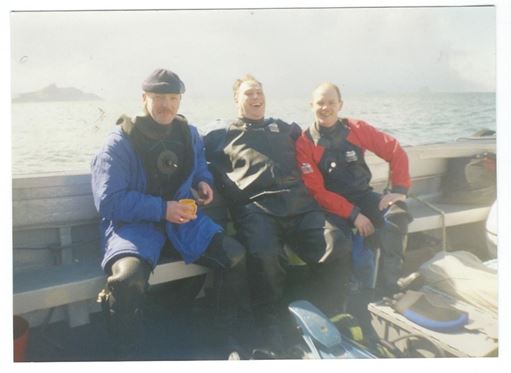
As ever, I have to thank those that have made this piece what it is, Mr Des Lavelle of Lavelle’s Valentia Diving Centre, for our trips to Crompton and, in this case, it would have been a far less interesting tale without the help of Michael Lynch, of the Kerry County Library, who provided the articles from the Kerry Evening Star, the Kerry Evening Post, the Cork and the Irish Examiner and to both of whom I am, and will remain, eternally grateful

My grandfather was part of the crew on the Crompton. All my life I’ve heard stories of this shipwreck. We have many letters that he wrote back to his sister in United States, as he was required to stay for the trial of the captain. Or so I understand. Fascinating!
Lyndon,
Thank you for getting in touch, lovely to hear from a relative of someone aboard! I hope the piece was of interest to you? If there is anything from your grandfather’s letters that you think might add to the piece, or on the off chance family photos on or of her I’d be delighted to take a look and discuss adding them as an “epilogue” piece, I did that on the John R Kelly if you want to take a look and see what that looks like as an example? Anyhow thanks for saying hi & Best Regards
Colinj
Colin wonderful article. Thank you
Pauline, that’s most kind of you, thank you, I’m glad you enjoyed it!
Best Regards
Colinj
Lyndon I would love you to get in touch as captain was a member of my in-laws family and I’ve been doing some research for them.